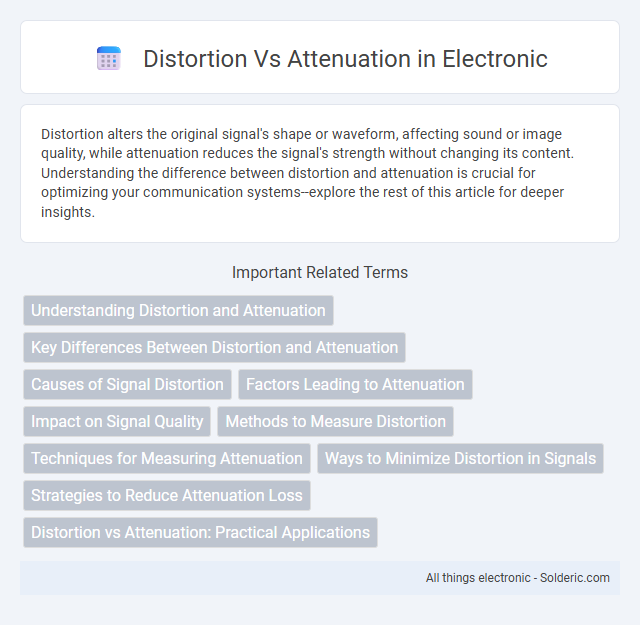Distortion alters the original signal's shape or waveform, affecting sound or image quality, while attenuation reduces the signal's strength without changing its content. Understanding the difference between distortion and attenuation is crucial for optimizing your communication systems--explore the rest of this article for deeper insights.
Comparison Table
| Aspect | Distortion | Attenuation |
|---|---|---|
| Definition | Alteration of the original signal's shape or waveform. | Reduction in signal strength or amplitude during transmission. |
| Effect on Signal | Changes signal characteristics, causing errors or loss of information. | Decreases signal power without changing its original form. |
| Cause | Non-linearities, noise, or channel impairments affecting signal integrity. | Physical medium resistance, distance, or energy dissipation. |
| Measurement | Measured using signal-to-noise ratio, total harmonic distortion (THD). | Measured in decibels (dB) as loss of signal power. |
| Impact | Degrades signal quality causing errors in communication. | Weakens signal, potentially reducing communication range or clarity. |
| Mitigation | Use of equalizers, signal processing, error correction. | Use of amplifiers, repeaters, better transmission media. |
Understanding Distortion and Attenuation
Distortion occurs when the original signal's shape is altered, affecting sound or image quality, while attenuation refers to the reduction of signal strength over distance or through a medium. Understanding distortion helps in identifying issues like phase shifts, harmonic generation, or nonlinearities, whereas attenuation focuses on signal loss that may cause fading or decreased amplitude. Both factors critically impact communication systems, requiring tailored solutions such as equalization for distortion and amplifiers for attenuation to maintain signal integrity.
Key Differences Between Distortion and Attenuation
Distortion alters the original signal's waveform, causing changes in amplitude, frequency, or phase, which can degrade audio or data quality. Attenuation refers to the reduction in signal strength or amplitude as it travels through a medium, resulting in a weaker output without changing the signal's waveform. Understanding these key differences helps you diagnose whether signal degradation is due to quality loss (distortion) or signal power loss (attenuation).
Causes of Signal Distortion
Signal distortion primarily results from non-linearities in transmission media and equipment, causing alterations in the waveform and phase of the signal. External factors such as electromagnetic interference, impedance mismatches, and signal reflections also contribute significantly to distortion. Understanding these causes helps you implement proper shielding and impedance matching to maintain signal integrity.
Factors Leading to Attenuation
Attenuation primarily results from signal loss due to distance, medium imperfections, and obstacles that absorb or scatter energy. Environmental conditions such as humidity, temperature, and physical obstructions like walls can significantly increase the rate of attenuation in wireless and wired communication systems. Material properties, including conductor resistance and dielectric losses in cables, further contribute to signal weakening over transmission paths.
Impact on Signal Quality
Distortion alters the original shape or waveform of a signal, causing loss of fidelity and making accurate data interpretation difficult. Attenuation reduces signal amplitude, leading to weaker signals that increase the risk of noise interference and decreased signal-to-noise ratio. Both phenomena degrade signal quality but affect communication systems differently, requiring distinct corrective measures like equalization for distortion and amplification for attenuation.
Methods to Measure Distortion
Methods to measure distortion include Total Harmonic Distortion (THD), which quantifies harmonic frequencies generated by nonlinearities in an audio signal, and Intermodulation Distortion (IMD), assessing distortion products from the interaction of different frequencies. Tools like spectrum analyzers and distortion analyzers enable precise measurement by separating fundamental signals from distortions in frequency domains. Your choice of method depends on the type of distortion to be evaluated and the accuracy required for your specific application.
Techniques for Measuring Attenuation
Techniques for measuring attenuation include using optical time-domain reflectometers (OTDR), which analyze backscattered light to determine signal loss along fiber optics. Another method involves employing power meters and light sources to compare input and output power, providing precise attenuation levels. You can also use insertion loss measurements to quantify the reduction in signal strength caused by components or connectors within a transmission system.
Ways to Minimize Distortion in Signals
Minimizing distortion in signals involves maintaining signal integrity through proper impedance matching and using high-quality components to reduce nonlinearities. Employing equalization techniques and digital signal processing helps correct frequency response deviations and phase shifts. Shielding cables from electromagnetic interference and ensuring proper grounding also play crucial roles in preserving signal fidelity.
Strategies to Reduce Attenuation Loss
Strategies to reduce attenuation loss include using high-quality materials like low-loss cables and fiber optics, optimizing signal amplification through repeaters or amplifiers, and maintaining proper cable installation with minimized bending and physical damage. Employing frequency equalization and impedance matching also enhances signal strength over long distances, ensuring clearer transmission. You can significantly improve communication system performance by implementing these attenuation-reduction techniques.
Distortion vs Attenuation: Practical Applications
Distortion alters the original signal's waveform, causing changes in tone and clarity, which affects audio quality in music production and telecommunications. Attenuation reduces signal strength over distance, crucial in designing communication systems like fiber optics and radio transmissions to ensure signal integrity. Your ability to manage both distortion and attenuation directly impacts the performance and reliability of audio and communication devices.
Distortion vs attenuation Infographic

 solderic.com
solderic.com